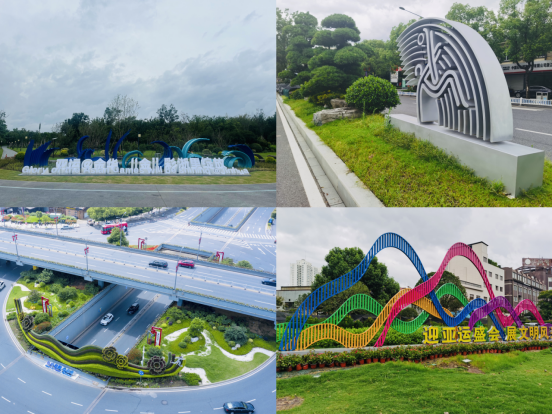发布时间: 2023-08-30


The appearance of several significant projects, like the Jinhua Entrance on the Shanghai-Kunming High-Speed Railway, Dongshi Street, and the “Three Rivers, Six Banks” landscape, has been greatly enhanced. Places like pocket parks, urban post stations, and boulevards have become popular spots for the local residents. The road network, municipal facilities, parks, and squares, along with other essential amenities, are continuously being improved. With the Asian Games approaching, Jinhua’s 17.3 billion RMB investment in 200 urban enhancement projects is nearing completion, revealing a transformed cityscape.
The transportation gateway serves as Jinhua’s first impression and holds significant importance in enhancing the city’s quality for the upcoming Asian Games. The entire city has developed tailored enhancement plans for 12 major highway entrances and 5 high-speed rail stations, focusing on upgrading traffic facilities, creating appealing landscape points, enhancing lighting, and adding Asian Games-themed elements. A total of 560 million RMB has been invested in these efforts.
The Jinhua entrance of the Shanghai-Kunming Expressway is right next to Zhejiang Normal University Stadium. Jinhua has come up with a plan to enhance this area, focusing on “one entrance, one park, two roads, and three fields.” This plan aims to facilitate the relocation of nearby urban villages, establish a large grassy slope landscape that adds more greenery to the surroundings, create the Song Yun Cultural Park, and carry out improvements to Yingbin Avenue and Second Ring North Road. Since opening in early July, the area has welcomed over 2,000 visitors daily for sightseeing and photo-taking, turning it into a popular spot.
Focusing on the 34 Asian Games commuting routes, the city has taken a comprehensive approach, considering both main urban roads and important national and provincial routes. The efforts include five major initiatives: revamping flat roads, adding greenery and vibrancy, illuminating night scenes, enhancing urban amenities, and upgrading building facades. These actions aim to improve the city’s functionality and aesthetics across various dimensions, including ground-level, above-ground, day-time, and night-time perspectives. According to data, the city has already improved the smoothness of 350 kilometers of roads, completed greening projects along 97 kilometers of roads, replanted 4,309 roadside trees, and established 160 Asian Games-themed landscape spots.
The section of Dongshi Street from Second Ring North Road to Haitang, spanning 8.42 kilometers in total, serves as both an Asian Games commuting route and a torch relay path. By extending, widening, and renovating, it has undergone improvements in both upper and lower sections, enhanced lighting, and facade upgrades. This project also includes standardizing transportation facilities and urban furniture, making it a model demonstration road for Asian Games commuting.
As of now, the city has revamped 200 bus shelters and 44 BRT platforms, while 50 parks have introduced new navigation systems, offering more considerate services. The city has also engaged its residents in adopting 2,100 trees and developing 1 hectare of green space. Furthermore, 2,010 bird nests and feeders have been placed in parks and along tree-lined avenues, as part of the “Thousand Nests” project launched to welcome the Asian Games. This effort aims to attract a greater number of birds to nest and establish their homes within the urban environment. (By Xu Zhaohui)
| 1 | 2 | > | >> |

